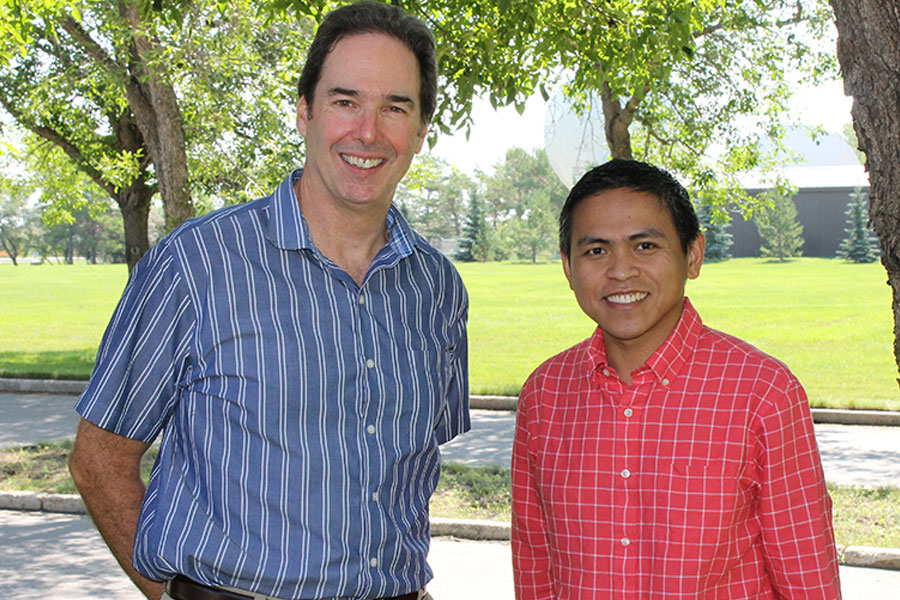
Making a splash in Nature
Although only in his second year as a PhD student, Jaivime Evaristo is making a splash in the world of water research.
By University Communications
The U of S School of Environment and Sustainability (SENS) student is the lead author on a paper published in the September 3 issue of Nature that sheds new light on how water moves through soil to nourish plants, recharge water stocks and discharge in streams.
"The prevailing view in the field assumes that beneath the soil surface lies one huge tank where all water ‘meets, greets, and mixes'," said Evaristo. In fact, his research shows that around the world, water is compartmentalized, with plants using soil water that does not contribute to groundwater recharge or stream flow.
Evaristo's research followed that of his supervisor and co-author Jeffery McDonnell, SENS professor and associate director of the Global Institute for Water Security. In a paper published in 2010, McDonnell and colleagues first challenged the single-mixing-tank model, tracking for the first time the isotope composition of mobile and immobile water at the watershed scale.
"Jaivime's PhD findings have the potential to change how we view the hydrological cycle – from what we teach in grade 10 science to academic research in related ecosystem and soil biogeochemical studies. It's a huge finding," said McDonnell. "I'm very impressed with the quality of Jaivime's work on challenging current theories. It speaks to the caliber of water research undertaken at the U of S and the quality of the SENS graduate program."
One unique aspect of Evaristo's work was using the scientific equivalent of crowd sourcing to collect data from 47 study sites around the world and using that data to calculate the extent of ecohydrological separation between plant water and groundwater.
"My mission is to show myself that what we have found in field studies at Jeff's sites in Oregon and Mexico and my MSc research site in Puerto Rico is something that is ubiquitous in nature," said Evaristo, freshly back from six months studying these processes under controlled conditions at the Biopshere-2 facility near Tucson, Arizona.
Both Evaristo and McDonnell hope that their findings will inform new tool development that will more accurately predict water quantity and quality in diverse environments and how different parts of the world will respond to climate change and land-use change.
You can read the Nature article here.
"The prevailing view in the field assumes that beneath the soil surface lies one huge tank where all water ‘meets, greets, and mixes'," said Evaristo. In fact, his research shows that around the world, water is compartmentalized, with plants using soil water that does not contribute to groundwater recharge or stream flow.
Evaristo's research followed that of his supervisor and co-author Jeffery McDonnell, SENS professor and associate director of the Global Institute for Water Security. In a paper published in 2010, McDonnell and colleagues first challenged the single-mixing-tank model, tracking for the first time the isotope composition of mobile and immobile water at the watershed scale.
"Jaivime's PhD findings have the potential to change how we view the hydrological cycle – from what we teach in grade 10 science to academic research in related ecosystem and soil biogeochemical studies. It's a huge finding," said McDonnell. "I'm very impressed with the quality of Jaivime's work on challenging current theories. It speaks to the caliber of water research undertaken at the U of S and the quality of the SENS graduate program."
One unique aspect of Evaristo's work was using the scientific equivalent of crowd sourcing to collect data from 47 study sites around the world and using that data to calculate the extent of ecohydrological separation between plant water and groundwater.
"My mission is to show myself that what we have found in field studies at Jeff's sites in Oregon and Mexico and my MSc research site in Puerto Rico is something that is ubiquitous in nature," said Evaristo, freshly back from six months studying these processes under controlled conditions at the Biopshere-2 facility near Tucson, Arizona.
Both Evaristo and McDonnell hope that their findings will inform new tool development that will more accurately predict water quantity and quality in diverse environments and how different parts of the world will respond to climate change and land-use change.
You can read the Nature article here.

